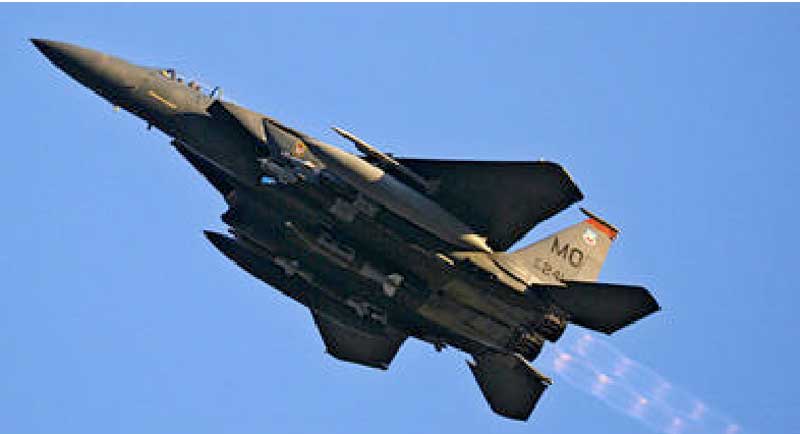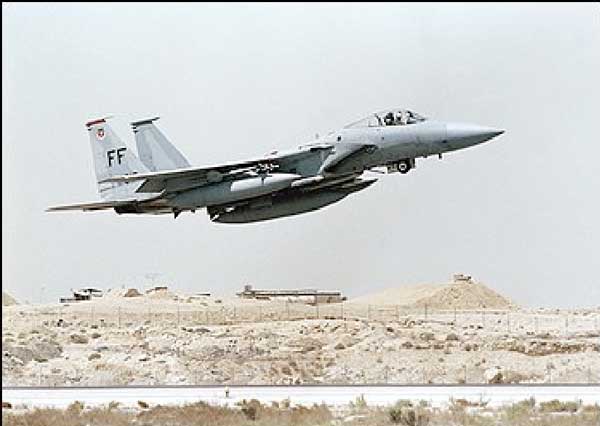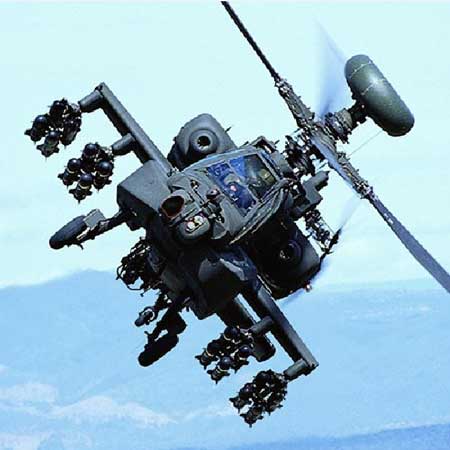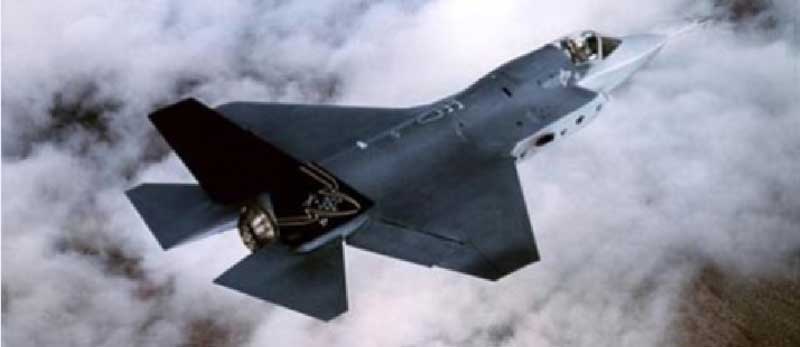10/16 /2010 – The Pentagon’s Defense Security Cooperation Agency is expected to confirm soon an estimated $60 billion U.S. arms deal with Saudi Arabia. The unstated but widely understood purpose of the sale, which has been under discussion since 2007, is to enhance the Kingdom’s ability to defend itself against Iran.
Another objective is to highlight Washington’s commitment to Saudi Arabia and the other U.S. allies in the Persian Gulf despite the end of the U.S. combat role in Iraq and the Pentagon’s difficulties in Afghanistan. Sustaining the U.S. role as the Kingdom’s main foreign arms supplier is also an important goal.
The Defense Department has not yet provided the details of the proposed arms sales package to Saudi Arabia. According to the available public information, half of the $60 billion package will likely comprise authorization to buy new military hardware, while the other $30 billion will probably consist of possible upgrades to Saudi Arabia’s existing weapons as well as other support costs.
 A U.S. Air Force F-15 fighter jet on a low-level flyby, eastern Afghanistan, January 1, 2009, Bob Strong/Reuters/File (Credit: Christian Science Monitor, http://www.csmonitor.com/World/Global-News/2010/0914/Why-60-billion-in-US-arms-to-Saudi-Arabia-isn-t-causing-an-outcry)
A U.S. Air Force F-15 fighter jet on a low-level flyby, eastern Afghanistan, January 1, 2009, Bob Strong/Reuters/File (Credit: Christian Science Monitor, http://www.csmonitor.com/World/Global-News/2010/0914/Why-60-billion-in-US-arms-to-Saudi-Arabia-isn-t-causing-an-outcry)
There may also be additional components, currently under discussion and valued at up to another $30 billion, that would include naval weapons such as helicopter carrying patrol boats and littoral combat ships as well as possible additional missile defense systems.
The main items of the core $60 billion package would likely include:
- 84 new Boeing F-15 combat aircraft (these will replace the Saudi Air Force’s aging fleet of F-16C/Ds, acquired from 1978 to 1992, though it is still unclear what radar and other systems the more advanced replacement planes might have)
- Upgrades to 70 existing Saudi F-15S strike aircraft (perhaps with longer-range missiles mated to these Saudi-adopted version of the Boeing F-15E)
- 60 new AH-64D Longbow Apache attack helicopters and upgrades to Saudi Arabia’s 12 existing AH-64As
- 72 additional UH-60 Black Hawk utility helicopters (to supplement Saudi Arabia’s existing 22 UH-60s)
- Upgrades to the existing 96 Patriot Advanced Capacity-2 (PAC-2) air and missile defense systems
The $60 billion figure can be misleading. That total is simply an authorized aggregate ceiling of the value of all the possible systems and related defense items Saudi Arabia can potentially buy from the United States.

The actual volume of purchases is likely to be lower, perhaps by a considerable amount. In addition, the specific transactions (which typically include support packages and other detailed terms) will probably take years to negotiate and implement given prudential Saudi financing due to the volatility of world oil prices, the country’s limited absorption capacity, as well as the time needed to manufacture the planes, prepare Saudi infrastructure to receive the weapons, and train the Saudi operators to use the new systems. All this means that the annual sales totals could plausibly amount to a few billion dollars each year for a decade or more.
Advocates of selling more American weapons to Saudi Arabia and other U.S. allies in the Persian Gulf can and do cite several reasons to support the transaction.
First, the new systems if properly and effectively integrated would strengthen Saudi Arabia’s armed forces and thereby help balance and deter Iran’s growing military power. Even without Iran’s acquisition of nuclear weapons, the Iranian military has been displaying a growing range of conventional capabilities, showing off new missile, naval, and air capabilities as well as expanding the Iranian ground forces.
Although few expect the Iranian military to attack Saudi Arabia out of the blue, the worry exists that Iran might pursue that option during a crisis, most likely by disrupting Saudi Arabia’s oil exports through the Persian Gulf to underscore Tehran’s ability to exploit Western dependence on Persian Gulf energy supplies and to threaten the health of the global economy.
The United States has been seeking to enhance missile defense capabilities throughout the Persian Gulf region—by placing American-run, ground-based missile defense systems in several Gulf states, by stationing specially equipped U.S. Navy missile ships in the Gulf’s waters, and by selling several types of missile defense systems to Saudi Arabia and other members of the Gulf Cooperation Council (GCC).
The systems sold to the GCC include both the low-altitude Patriot and the higher-altitude Terminal High Altitude Area Defense (THAAD) systems, which together have the potential to provide a more comprehensive layered missile and air defense network than either system in isolation, especially when networked with the U.S.-operated missile-defense systems.
Although imperfect, they would contribute to protecting the GCC’s energy production and distribution infrastructure, including shielding the tankers conveying oil through the Gulf. Even the most optimistic scenarios for the increased use of renewable energy still forecast continued Western dependence on Saudi Arabia’s petroleum exports for the international economy.
Secondly, regional experts believe the sales would also reassure Riyadh about Washington’s commitment to help defend Saudi Arabia and its allies against Iran and possibly other security threats despite developments in Iraq and Afghanistan.
Unfortunately, the U.S. combat withdrawal from Iraq and the Pentagon’s frustrations in Afghanistan have made many Saudis fear that the United States will reduce its military presence in the Persian Gulf and will become more reluctant to defend Saudi interests with military power. And as Robbin Laird’s companion piece suggests, showing how these modernizations fit into regional collaboration and U.S. leadership needs to be demonstrated not assumed.
Some Saudis fear that a pro-Iranian faction could gain political influence in Baghdad, confronting Saudi Arabia with a pair of aligned Shiite governments. Even if Baghdad remains independent of Tehran’s influence, Iraq will take years to develop the military power needed to again serve as a regional balancer of Iran, even if the Iraqi government wanted to perform this role. In this context, the arms sale would serve as a tangible reaffirmation to Saudis that the U.S. security umbrella remains valid.
Third, U.S. advocates of the Saudi arms deal want to rely at least partly on regional allies to help contain and deter the Iranian military. In their view, the transferred weapons would ease the burden on the overstretched U.S. military and the overburdened American taxpayer of countering Iran. In this context, Saudi Arabia is a logical local ally for Washington given the weakness of Iraq, Iran’s traditional rival, and the limited military potential of the other Gulf states. Fortifying the Saudi Arabian military with additional weapons would help achieve Washington’s regional security goals, especially balancing and containing Iran.
The sales could also prove militarily useful by promoting defense interoperability among U.S. allies in the Persian Gulf—both among themselves and with U.S. forces. But again a potential is not a reality. Without significant U.S. investment and engagement in shaping real collaborative capabilities in the region, all that would be happening is transferring capabilities to an ally for purely national purposes. Arms sales need to be accompanied by hard work in making systems work together for enhanced common defense. A sale is not a capability.
In recent years, the United States has been selling weapons to other Persian Gulf states concerned about a potential power vacuum in the region or about Iran’s growing strength. The United Arab Emirates, Kuwait, and the other members of the GCC have been especially prolific buyers. Although the GCC presently lacks the coherence—having limited means of coordination, integration, and standardization—to contain Iran on its own, equipping all their members with U.S.-made weapons, and training them to use them, can bolster their capabilities, especially in partnership with the Pentagon.
In some scenarios, U.S. troops might use some of these weapons as they rush to reinforce the region. This would especially be necessary given the cancellation of the F-22. Even for more limited engagements, having access to the data generated by Saudi Arabian missile defense radars and other sensors could prove useful for defending U.S. forces and other targets in the Gulf.
In addition, supporters of the arms deal argue that U.S. arms sales to Saudi Arabia help sustain American influence in Riyadh, which can encourage Saudi officials to continue to support policies favorable to U.S. interests. These include Saudi Arabia’s consistently moderate policies toward Israel, its sponsorship of inter-faith dialogue, its domestic deradicalization program, its restraining influence on the foreign policy of Syria and other disruptive regimes, and the high level of U.S.-Saudi intelligence cooperation against international terrorism.
Furthermore, the proposed deal with the United States would contribute to saving or creating an estimated 75,000 American jobs. Most of these would result from keeping Boeing’s St. Louis F-15 production line open for an additional half-decade or so, providing a bridge until the next major order occurs, and would partially compensate for last year’s cancellation of several planned purchases from Boeing by the Pentagon.
Other companies would benefit, including the AH-64D Apache Longbow helicopter production facilities of Northrop Grumman (Linthicum, Md.) and Lockheed Martin (Oswego, N.Y.). In addition, Sikorsky Aircraft, a division of United Technologies Corp., would produce the UH-60 Black Hawk plants at its facilities in Stratford, Conn., with assistance from the General Electric plant at Lynn, Mass.
 Apache Longbow (Credit: http://blog.lib.umn.edu/deg/campfire/images/ah64_2.jpg)
Apache Longbow (Credit: http://blog.lib.umn.edu/deg/campfire/images/ah64_2.jpg)
The weapons sales also help recycle the petrodollars Saudi Arabia acquires from oil exports—as well as encouraging Saudi Arabia to work with American firms in developing their energy sector and other infrastructure.
Finally, U.S. arms sale backers fear that, if Washington declines to provide the Saudi government with adequate defensive weapons, then Riyadh would likely pursue other means of strengthening its security. The key target for such backers is European suppliers.
Most likely, the Saudis, who have always sought multiple arms supply relationships as a hedge against a weakening of their ties with Washington, would buy the weapons from other suppliers. Saudi Arabia has already bought a number of European weapons in recent years, including multibillion-dollar contracts for the Eurofighter Typhoon fighter planes and a border security system from British-based firms, as well as some helicopters and artillery pieces from French suppliers. And one interesting question is how the new American systems will be integrated to operate with the advanced Eurofighter. A similar issue has existed for years in the UAE as the Air Force as F-16s and Mirages facing con-ops integration challenges.
The Saudis could plausibly purchase more weapons from China, which sold Saudi Arabia some intermediate-range missiles in the 1980s. The Saudis might also buy Russian arms to provide an additional incentive to dissuade Moscow from selling more sophisticated weapons to Iran.
It is possible, though unlikely, that the Saudi government might decide to conserve its resources and try to appease Tehran or, conversely, Riyadh might seek to acquire nuclear weapons as an ultimate deterrent. Whether Saudi Arabia relied on its emerging nuclear power program to manufacture nuclear weapons (which would take approximately a decade) or simply bought ready-made atomic bombs from Pakistan or other countries, Saudi Arabia’s acquisition of nuclear weapons would contribute to further nuclear proliferation in the Middle East, a development harmful to U.S. interests.
In terms of the scale and cost, this proposed deal dwarfs the previous U.S. military sales to Saudi Arabia. Several of the earlier U.S. defense packages—such as the 1981 sale of AWACS (Airborne Warning and Control System) and the 1992-1993 sale of 72 F-15s—alarmed Israel’s supporters in Congress, which required strong lobbying by the executive branch and other groups, as well as changes in the proposed package, to overcome. After the Defense Security Cooperation Agency issues formal notification of a planned arms sale, the Congress has 30 days to cancel or amend the sale.
On this occasion, Israel’s supporters have yet to evince much public opposition to the newly planned sales. One factor dampening Israeli concerns is that Saudi Arabia already possesses many of proposed weapons systems, so the sale would not represent a major qualitative leap in Saudi military potential. Many would expand capabilities currently in limited supply, while others would complement Saudi Arabia’s existing panoply of American- and European-made weapons.
In addition, the United States has reportedly agreed not to outfit the weapons platforms provided Saudi Arabia with the most advanced capabilities suitable for attacking Israel, such as long-range stand-off weapons. Instead, they will be equipped with the modest armaments the United States normally sells with export versions of these warplanes.
The United States is also prepared to sell Israel even more advanced weapons to help sustain its military superiority. State Department spokesman P.J. Crowley has insisted that, “The United States would do nothing that would upset the current balance (of power) in the region.”
The Israeli ambassador to the United States, Michael Oren, has acknowledged that his defense experts “appreciate the administration’s efforts to maintain Israel’s qualitative military edge, and we expect to continue to discuss our concerns with the administration about the issues.”

In particular, Israel will soon purchase 20 of the new U.S F-35 stealth fighters at a cost of $2.75 billion. Lockheed Martin has stated the new fighter will be available for delivery in 2015, about the same time the F-15s will be supplied to Saudi Arabia. Finance Minister Yuval Steinitz and some other Israeli officials had expressed reservations about buying the F-35s. Although a $3 billion U.S. grant would cover their initial acquisition costs, Israel would still need to pay for the pilot training, hangar construction, repair facilities, and the planes’ long-term maintenance. In addition, the terms offered Israel would prohibit Israel from equipping the F-35s with Israeli-made weapons or tracking systems.
But another important reason for the lack of Israeli objections on this occasion is that, unlike during the 1980s and 1990s, many Israeli strategists now consider Iran, rather than the Arab countries, as presenting the greatest external threat to Israel’s security. And the new weapons the United States is providing Saudi Arabia and other Arab countries in the Persian Gulf would help contain Iranians’ growing military power and regional security ambitions.
Although the sale is likely to go through, and the Saudis have expressed potential interest in acquiring additional naval weaponry as well as more sophisticated missile defense, Saudi Arabia should balance its purchase of advanced Western weaponry with additional capabilities and training optimized to respond to another type of threat: low-intensity conflicts or insurgencies.
Asymmetric warfare against advanced militaries has proven to be an effective strategy in recent years. Although analysts differ over the extent to which the Iranian government has been aiding the Houthi rebellion in northern Yemen, which spilled over into a firefight with Saudi troops during the past year, it is not inconceivable that Saudi Arabia could face more direct guerrilla attacks from Yemen or elsewhere along its lengthy border fomented by Iranian sponsors. The Kingdom should continue to keep its intelligence and law enforcement agencies well equipped and trained to counter homegrown threats as well.

